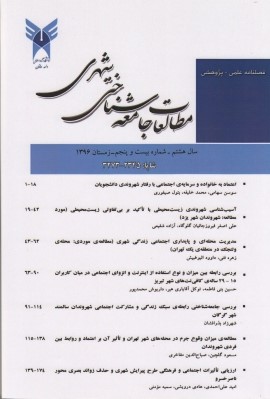ارائه مدلی عمومی برای محله جرمخیز
محورهای موضوعی : Urban Sociological Studiesمصطفی اجتهادی 1 , صلاح الدین قادری 2 , فرشید خضری 3
1 - دانشیار گروه علوم اجتماعی دانشگاه شهید بهشتی
2 - استادیار گروه علوم اجتماعی دانشگاه خوارزمی
3 - دانشجوی دکتری جامعه شناسی دانشگاه شهید بهشتی(نویسند مسئول)
کلید واژه: محله, محله جرمخیز, ساختارهای بیرونی محله, ویژگیهای ساختاری محله, عوامل و سازوکارهای علی,
چکیده مقاله :
وجود نظریهها و مطالعات متعدد درباره جرم در سطح محله بهرغم داشتن نقاط مثبت دچار نوعی تقلیلگرایی و ابهام هستند. بسیاری از این مطالعات در بررسی جرم به عوامل یکی از حوزهها مانند اجتماعی، اقتصادی، فرهنگی و محیطی توجه کردهاند و قادر به مطالعه نظاممند جرم در سطح محله نبودهاند. همچنین نظریهها و مطالعاتی که سعی کردهاند مدلی ترکیبیتر برای مطالعه جرم در سطح محله ارائه دهند بازهم بهخوبی قادر به ترکیب سطوح و ابعاد مختلف نبودهاند. هدف این مقاله ارائه مدلی چندبعدی و چندسطحی با تأکید بر عوامل و سازوکارهای علی برای توضیح جرم در سطح محله است. این مقاله بدون اینکه ادعای ارائه نظریه داشته باشد تلاش میکند با مرور فشرده نظریههای موجود در ابعاد اجتماعی، فرهنگی، اقتصادی و محیطی و ترکیب آنها مدلی عمومی برای مطالعه جرم در سطح محله ارائه دهد. مقاله میکوشد توان تبیینی و توضیحی مطالعات حوزه محله و جرم را بالا ببرد. میزان موفقیت این هدف مشروط به آزمون این مدل با استفاده از دادههای درون و بین محلهای و همچنین نقد آن توسط محققان این حوزه است. مدل ارائهشده در این مقاله مدلی چندبعدی و چندسطحی است بهگونهای که تلاش شده ویژگیهای بیرونی و درونی محله همراه با قدرت عاملین جمعی و فردی را برای تبیین و توضیح جرم ترکیب کند.
The existence of numerous theories and studies about crime at the level of neighborhood, despite having positive points, suffers from certain kinds of reductionism and ambiguity. Many of these studies have focused on social, economic, cultural and environmental variables as the prime causes of crime, and have not systematically studied crime at the neighborhood level. Also, theories and studies that have tried to provide a more integrated model for crime analysis at the neighborhood level are still not well suited to combining different levels and dimensions. The purpose of this paper was to present a multidimensional and multilevel model emphasizing the causal factors and mechanisms for explaining crime at the neighborhood level. Without attempting to present a theory, this article tries to provide a comprehensive model for community-based crime studies by reviewing existing theories on social, cultural, economic and environmental dimensions and combining them. The article tries to increase the explanatory power of neighborhood and crime studies. The success rate of this goal is conditional on testing this model using data within and between neighborhoods and also on being criticized by researchers in this area. The model presented in this paper is a multidimensional and multilevel model in which it attempts to combine the external and internal characteristics of the neighborhood with the power of collective and individual actors to explain the crime.


